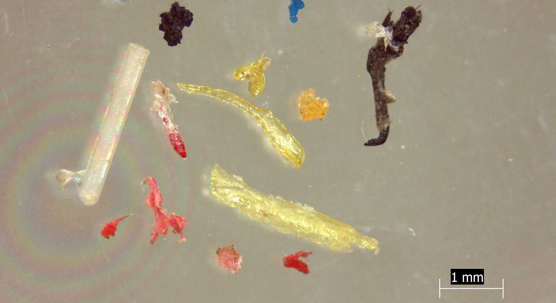Microlitter – A Challenge for Wastewater Treatment Plants
Published on by Water Network Research, Official research team of The Water Network in Academic
Finnish Environment Institute Researcher and M.Sc. Julia Talvitie’s doctoral dissertation indicates that wastewater treatment plants function well overall for microlitter removal.
The vast majority (approx. 99%) of microlitter of 20 micrometers is removed using the normal treatment methods currently in use.

The term microlitter normally refers to litter items less than 5 mm in diameter. © Photo: Julia Talvitie, Via Syke
‘The proportion which gets through into the waterways could still represent a significant burden for the environment, however, because a large amount of wastewater goes through the treatment plants’, Ms Talvitie explains.
The term microlitter normally refers to litter items less than 5 mm in diameter. Microlitter and especially microplastic have in recent times received more and more attention as an environmental problem. This form of litter gets into the environment from a number of different sources such as traffic, textiles and cosmetics.
It is suspected that one of the significant routes through which microlitter gets into the waterways is via wastewater treatment plants, as current water treatment technology is not specifically designed for removing microlitter. However, little is currently known about how well treatment plants remove microlitter in practice and how much microlitter ends up in the waterways.
Environmental burden can be reduced using new technologies
Microlitter can be found in treated wastewater, including microscopic textile fibres and plastic granules used in cosmetics. In her research, Talvitie estimates that around 480 billion pieces of microplastic particles pass via Finnish wastewater flows into natural waters every year.
The environmental burden could be significantly reduced by integrating the latest treatment methods into wastewater treatment plants. According to the research, microlitter can be removed from treated wastewater by using various advanced treatment processes.
The most effective method has been shown to be the membrane filter bioreactor, which is based on membrane filtration technology and was able to remove almost all the microlitter (99.9 %). Other effective methods were sand filters, flotation and disc filters.
Textile fibres found in Baltic Sea mussels
The doctoral work also examined the levels of microlitter found in waterways that receive the wastewater. It was observed that Baltic Sea mussels in marine areas that receive wastewater contained significantly higher levels of microlitter than those in reference areas, not subjected to any known anthropogenic activity. The microlitter found in these mussels was generally composed of textile fibres.
The observed higher levels of microlitter could result from the output of the wastewater treatment plants, however, the impact of other possible sources and routes of microlitter could not be ruled out. ‘We still need more information about other possible microlitter sources and the routes that it takes in order to carry out reasoned and effective counter-measures’, Ms Talvitie concludes.
Electronic dissertation: Wastewater treatment plants as pathways of microlitter to the aquatic environment
Read full article: Syke
Media
Taxonomy
- Reclaimed Wastewater
- Wastewater Treatment
- Contaminant Removal
- Contaminant Movement Mapping
- Plastic Parts
- Plastics
- Contaminant Control
- Plastic Pollution